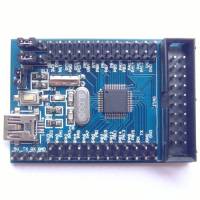This is an old revision of the document!
# STM32F103C8T6 Dev. board
## Overview
 I have had this board on a shelf for quite some time, but never used it before. Having nothing better to do this week-end, I gave it a try, and here is what I've found/done.
I have had this board on a shelf for quite some time, but never used it before. Having nothing better to do this week-end, I gave it a try, and here is what I've found/done.
It's a small development board, with a 20 pins JTAG connector, a MiniUSB connector and all (?) pins broken out on two rows on the side.
There's a 8Mhz quartz (with PLL, the chip can run at 72Mhz), a 32.768kHz quartz (for the RTC), and that's pretty much all, but for only 10 bucks… It's okay ![]()
## Bootloader
The board is shipped without any software, link, datasheet, or pre-loaded code. Luckily, the STM32 family chips often (always ?) embed a bootloader. For this chip, STM32F103C8T6, it's a Serial bootloader, which can be accessed on the top left UART header (the 4 pins next to the USB port).
I have tried flashing it with the SWD (that can be found in the JTAG header) with an ST-link programmer. I does work but requires some hardware. So the Serial bootloader…
Don't forget to set BOOT0 to 1 (and keep BOOT1 to 0) with the appropriate jumper on the board. Then, power or or reset the Board (with the onboard switch) and flash you binary ![]()
[redox@RedoXPS ~/STM32F103_Demo]$ stm32flash -w ./main.bin -v -g 0x0 /dev/ttyUSB0 stm32flash - http://stm32flash.googlecode.com/ Using Parser : Raw BINARY Serial Config: 57600 8E1 Version : 0x22 Option 1 : 0x00 Option 2 : 0x00 Device ID : 0x0410 (Medium-density) - RAM : 20KiB (512b reserved by bootloader) - Flash : 128KiB (sector size: 4x1024) - Option RAM : 16b - System RAM : 2KiB Wrote and verified address 0x08001e6c (100.00%) Done. Starting execution at address 0x08000000... done.
It should start right away. If you're using the USB port in your code, you will probably have to unplug and replug the board from your USB port (or else it won't enumerate…).
## USB bootloader
The serial bootloader is better than the JTAG stuff when you only need to flash your code. However, it requires an USB-Serial adapter, changing jumpers, … Not really friendly. So I looked for another method: an USB bootloader.
Keep in mind that you can easily screw up the USB bootloader, while the serial bootloader is much much harder (impossible ?) to accidentaly erase.
I haven't found many bootloaders that could work without an external switch, … So I settled on a modified version of the Maple bootloader. Another one would have been OpenBLT but the PC software seems Windows-only so… >_<
## Demo
## Links
